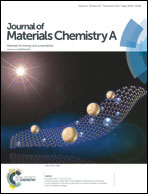Synthesis of hollow organosiliceous spheres for volatile organic compound removal†
Abstract
Hollow organosiliceous sphere (HOS) materials have been successfully synthesized by a co-condensation method with tetraethylorthosilicate (TEOS) and organosilane (1,2-bis(triethoxysilyl)ethane, BTSE) as mixed silica sources under acidic conditions. The application of HOSs as adsorbents for the volatile organic compound (VOC) abatement was demonstrated. The HOSs were characterized by transmission electron microscopy (TEM), N2 sorption isotherms, FT-IR spectroscopy, thermogravimetric analysis (TGA) and X-ray photoelectron spectroscopy (XPS). The results indicated that all samples showed a uniform hollow mesostructure and the organic groups were chemically incorporated into the walls of HOSs. The static adsorption and stability behaviors of water vapor, n-hexane and 93# gasoline on HOSs were investigated, with commercial silica gel (SG) and activated carbon (AC) as references. It was found that the sample with an initial molar ratio BTSE/(BTSE + TEOS) of 25% (HOS-25%) had the largest VOC adsorption capacity (1.36 g g−1n-hexane and 1.35 g g−1 93# gasoline) and the smallest water vapor adsorption capacity (0.0120 g g−1) under static adsorption conditions. The dynamic adsorption behaviors of n-hexane on HOS-25% were evaluated via breakthrough curves. The dynamic adsorption capacities of n-hexane are in the following order: SG < AC < HOS-25% and the stability is in the order of AC < SG < HOS-25%. The larger dynamic VOC capacity of the HOSs may be attributed to the synergetic effect between the unique morphology and hybrid walls. The static and dynamic n-hexane and water vapor competitive adsorption results suggested that HOS-25% had a much higher adsorption tendency for VOCs over water vapor. The HOSs with high hydrophobicity, large VOC removal capacity and excellent recyclability show great potential for VOC controlling.


 Please wait while we load your content...
Please wait while we load your content...